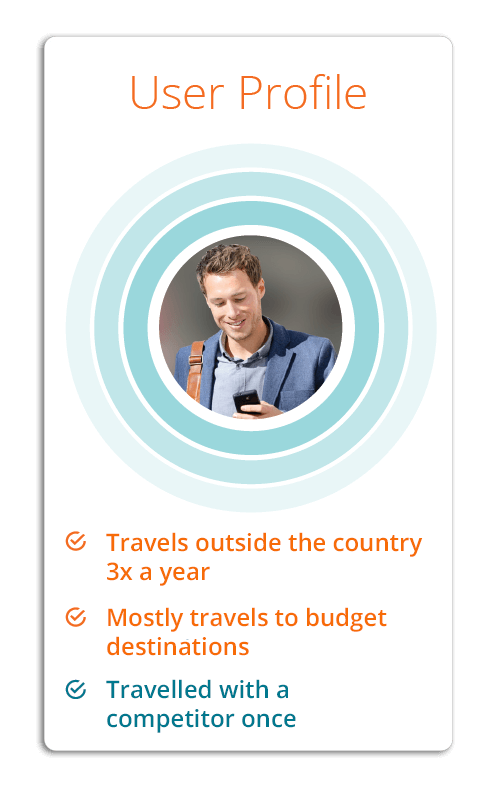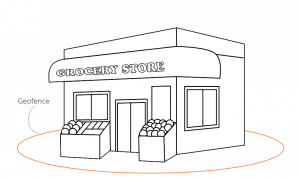Location-based marketing is a powerful and cost effective tool. But what exactly is meant by location based marketing? And how can you use this powerful mobile marketing strategy to help you boost sales in 2023? It is important to understand its ins and outs in order to decide if that’s something for your business.
We’ve put together a list of basics you should know about, including:
- What is location-based marketing and why use it
- Examples and use cases
- How it works
- The benefits of location-based marketing apps
- Try our free trial
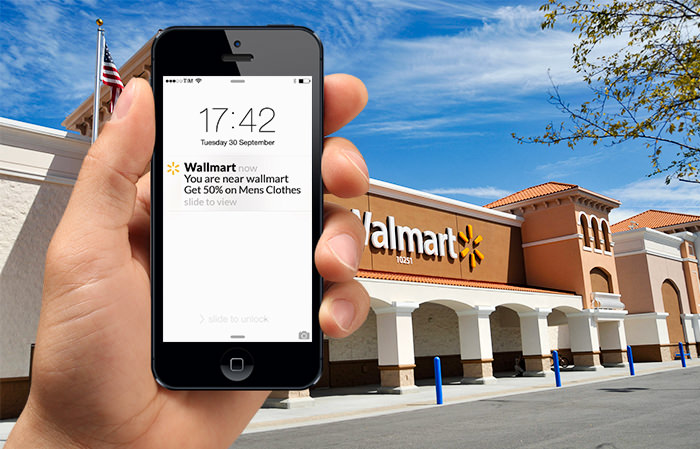
What is meant by location-based marketing?
Put simply, location based marketing refers to the process of using mobile device to target users based on their current or previously visited location, such as a city, a store or a certain aisle in a store. Sometimes referred to as geomarketing or proximity marketing, it’s made possible by powering apps with location technology such as geofencing so that app users can be targeted with marketing notifications and advertisements based on their geographical location.
If you haven’t started already, then you should think about incorporating it into your marketing strategy. A successful marketing strategy is not only one that helps you grow rapidly but also opens new doors and opportunities. And with the location-based advertising market projected to grow by over $80 billion between 2021 and 2025, now is the time to get on board.
When properly implemented, location-based marketing can be very effective at driving footfall for your business and will improve your marketing ROI. Although the idea of it can sound intimidating when new to it, the strategy is easier to implement than it might sound, especially when your partner with the right location software provider.
Look out for terms like ‘location based mobile marketing’, ‘location marketing’ and ‘mobile location marketing’ – these terms are often used interchangeably but pretty much mean the same thing.

How effective is location-based marketing?
Why use it? On average, interacting with users based on location leads to double the mobile engagement of regular mobile marketing messages, making it very effective!
Why does it bring such results? The principal benefit of targeting users based on location is the added relevancy of mobile messages – they are more adapted to users’ context and therefore more useful to them.
How many companies are using location marketing? According to a study by the Location Based Marketing Association, 25% of marketing budgets are spent on location based mobile marketing and over 50% of brands are using location data to target customers. Location is an increasingly critical element of digital marketing for brands and enterprises.
Is it right for your business? Usually, it is thought to only be useful to brick-and-mortar type of businesses. That is not the case. Since it relies on mobile devices, it is useful to all mobile-first businesses (a.k.a mobile apps) and app-owning businesses.
What if you don’t have an app? Without an app, it can be more challenging, but not impossible to implement location based mobile marketing. It would require connecting with a business that does have an app with location targeting installed, such as a voucher/coupon app. Most likely, it would be more of a “one-time” thing than an integrated part of your marketing strategy.
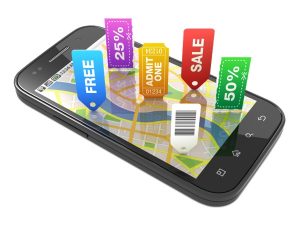
What is an example of location-based marketing?
Contrary to popular belief, sending notifications when a user is at a certain place is not what location based mobile marketing is all about, it’s just the tip of the iceberg. Here are some of the ways to use it.
Location marketing examples
- Sending location-based notifications (did we mention it already?)
- Collecting location data
- Building location-based user profiles
- Location-based re-targeting
Let’s go over them one by one.
What are the advantages of location-based marketing?
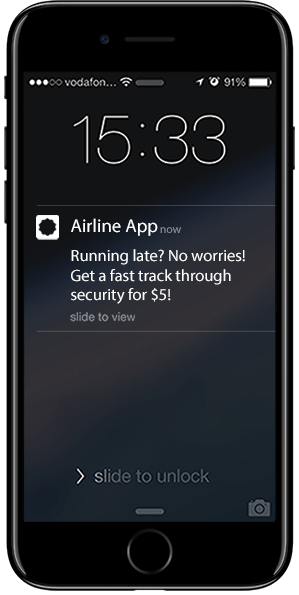
Location-Based Notifications
Location based notifications are the most known and popular way to use location based mobile marketing and are one of the major advantages. It involves sending notifications to app users when they enter, leave or stay in a certain area.
Examples? Here are some of the ways to use location based notifications:
- Upselling a customer of an airline right when he walks in the airport, by sending him a notification which promotes “skip-the-queue” services
- Capturing real-time feedback when customers of a hotel or booking app leave the hotel, by sending them a notification asking to rate their stay
Why use them? The goal of location -based marketing notifications is always to attract user’s attention, encourage him to visit the app and hopefully get him to complete a certain conversion action, for example redeem a coupon, rate a product or make a purchase.
Location Based Data
One of the least used but definitely the most valuable tool in location-based marketing is data about app users’ behaviors the the real world, such as foot traffic to certain locations, amount of time spent there etc. It is often referred to as location intelligence or location statistics/metrics.
Examples? There are a lot of interesting use cases for location marketing data. Here are some the most popular ones:
- Strategizing on where to open up an new branch of a food chain by using heatmaps to measure the distribution of customers across the city, state, or country
- Calculating the effectiveness of in-app or email promotions, by measuring foot traffic changes to a shopping mall and time users spent there (to see if they were just passing by or if they stayed there for a while and likely purchased something)
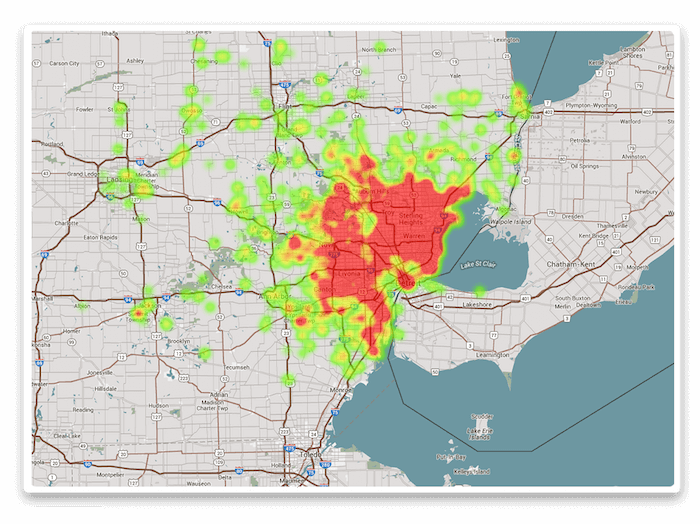
Why use it? The main benefit of location data is that it gives a better understanding of user’s whereabouts in the real world and it can, for example, show the direct impact of in-app and other marketing communications on app user’s physical behavior. App owners usually use this data to attribute offline conversions to their online efforts and figure out the ROI of their marketing channels.
Location Based User Profiles
Location based user profiles also make use of location data but in a slightly different way. Instead of counting visits to a certain location, they look at the type of places a user visits.
Examples? The most popular applications of location based user profiles are:
- Understanding the vacation preferences of a booking app user, by measuring how often he leaves the country, if he travels to premium or budget destinations, or if he travels with a competitor
- Understanding the lifestyle preferences of a ticketing app user, by analysing if he is often out in town on a Friday or Saturday night, or if he is mostly out during the day
Why use them? The main benefit of location profiles is enhanced personalization. They can be paired with data about user preferences to target them with very personalized messages. This is a way to improve user retention and loyalty that a lot of mobile apps are struggling with.
Location Based Retargeting
Location based retargeting also uses location data such as store visits to retarget users across other marketing channels – in-app, emails, banners etc.
Examples? Here are some of the ways to use location based retargeting:
- Showing a high-end car advertising via multiple channels to a user who has recently visited five BMW, Mercedes or Mazda dealerships
- Showing a mortgage advertising via multiple channels to a user who has recently visited 2 to 5 different banks
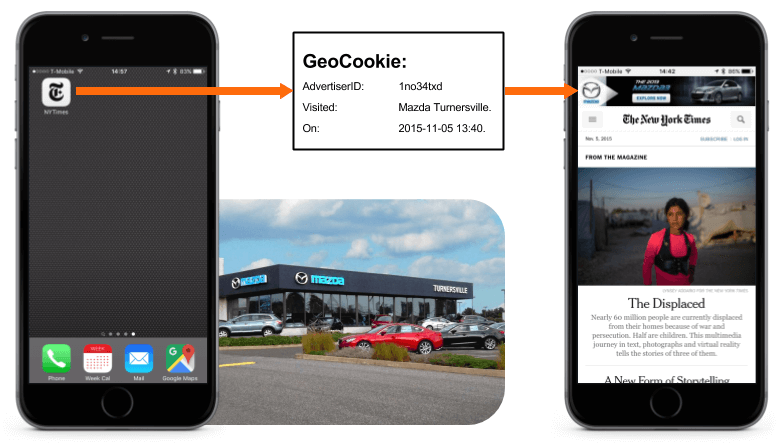
Why use it? The advantage of location based retargeting is that it’s more precise and therefore adds more relevance to any marketing channel. Going back to the car dealership example, would a single location based ad convert to a car sale? Mostly likely not, but it would make marketing messages more relevant and more likely to contribute towards a sale down the road.
3. How exactly does location marketing work?
Depending on the provider, location based mobile marketing relies on either geotargeting, geofencing and/or beacons. How are they different? They mostly differ in the way they generate location data.
Geotargeting
Geotargeting traditionally uses IP addresses to figure out where users are. It’s generally used to send out messages to all users in a specific area instantly (with a press of a button so to say). It is widely used in web-marketing, where you don’t need to get very precise. However, when it comes to mobile marketing, it’s mostly useful for things like breaking news and want to inform a bunch of users at once in an area as big as a city. But since geotargeting is not real-time, you can’t use it to collect info about users’ whereabouts, foot traffic, dwell or send real-time notifications.
Geofencing
Widely used in location-baed mobile marketing, geofencing uses triangulation of location services (cellular, WIFI towers etc.) to detect where users are in real-time. A geofence is a virtual fence around a real world location. Geofencing is the process of placing and using geofences to target app users as they enter, leave or stay within that area. It’s more useful for large range outdoors targeting. This usually means between 50-10,000m, for example on a scale of a shopping mall, or a neighbourhood. It doesn’t require hardware and usually comes in the form of a software that can be integrated into an app as well as with an online dashboard that is used for campaign management.
Beacons
Beacons rely on Bluetooth technology. A beacon is a Bluetooth signal transmitter that can be placed inside/at a real world location. Thanks to Bluetooth, Beacons can detect an app user that can then be targeted accordingly. Beacons are more useful for small range, highly granular targeting, usually between 1-50m, for example in an aisle of a store or in front of a check-in gate. Hardware (physical beacons) and its installation are required. Beacons also usually come with a software program and an online dashboard.
Get started with location marketing today
We hope these tips helped you understand what is location based mobile marketing and what are its common use cases! If you decide to give it a try, here is a list with the must-have features for a location based marketing provider.
To find out more about how our platform can drive results for your business, contact PlotProjects today. You can try our demo app for free, or download one of our customer’s apps to see how it works. Don’t have an app? No problem. We can create a custom geofencing app using the PlotProjects technology.
Other useful resources:
- What is geofencing?
- PlotProjects SDK best features and tools
- Beacon technology in retail – 9 strategies to boost sales
- Geofencing companies – how to choose the right one

